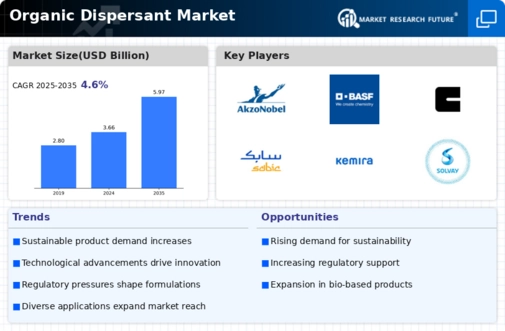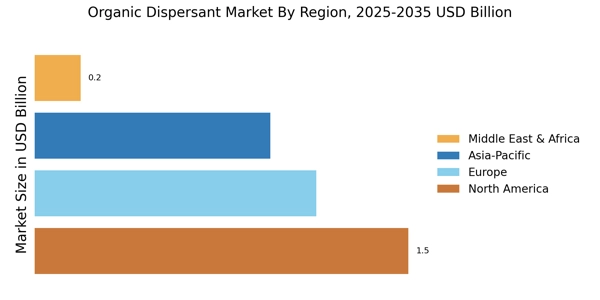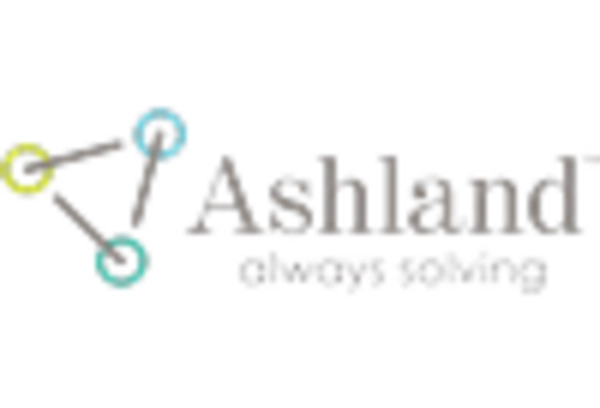Growth in End-User Industries
The expansion of end-user industries is a crucial driver for the Organic Dispersant Market. Sectors such as construction, automotive, and personal care are increasingly utilizing organic dispersants in their formulations. For instance, the construction industry employs organic dispersants in cement and concrete applications to improve workability and reduce water usage. Similarly, the automotive sector utilizes these dispersants in coatings and paints to enhance performance and durability. Recent market analysis suggests that the construction and automotive industries are projected to grow at rates of 5% and 4% respectively over the next few years, thereby driving demand for organic dispersants. This growth in end-user industries is expected to significantly contribute to the overall expansion of the Organic Dispersant Market.
Consumer Awareness and Education
Consumer awareness and education regarding the benefits of organic dispersants are increasingly shaping the Organic Dispersant Market. As consumers become more informed about the environmental and health impacts of chemical products, there is a growing inclination towards organic alternatives. Educational campaigns and initiatives by industry stakeholders are playing a vital role in disseminating information about the advantages of using organic dispersants. This heightened awareness is likely to influence purchasing decisions, leading to a shift in market dynamics. Market Research Future indicates that consumer preference for organic products is expected to rise by approximately 10% in the coming years. Consequently, the Organic Dispersant Market is poised to benefit from this trend, as manufacturers align their offerings with consumer expectations.
Rising Demand for Eco-Friendly Products
The increasing consumer preference for eco-friendly products is a pivotal driver in the Organic Dispersant Market. As environmental awareness grows, industries are shifting towards sustainable practices, leading to a heightened demand for organic dispersants. These products are perceived as safer alternatives to traditional chemical dispersants, which often contain harmful substances. According to recent data, the organic dispersant segment is projected to witness a compound annual growth rate of approximately 6% over the next five years. This trend is particularly evident in sectors such as paints and coatings, where manufacturers are actively seeking to reduce their environmental footprint. Consequently, the Organic Dispersant Market is likely to expand as companies innovate to meet these evolving consumer expectations.
Technological Innovations in Formulation
Technological advancements in the formulation of organic dispersants are propelling the Organic Dispersant Market forward. Innovations in chemical engineering and material science have led to the development of more effective and efficient dispersants that cater to diverse applications. For example, the introduction of nanotechnology in dispersant formulation has enhanced performance characteristics, such as stability and dispersion efficiency. This has resulted in a broader range of applications across various industries, including agriculture and pharmaceuticals. Market data indicates that the segment of technologically advanced organic dispersants is expected to grow at a rate of 7% annually, reflecting the industry's response to the demand for high-performance products. As such, the Organic Dispersant Market is likely to see continued investment in research and development to harness these technological advancements.
Regulatory Support for Sustainable Practices
Regulatory frameworks promoting sustainable practices are significantly influencing the Organic Dispersant Market. Governments worldwide are implementing stringent regulations aimed at reducing the environmental impact of industrial processes. These regulations often favor the use of organic dispersants over conventional options, thereby creating a favorable market environment. For instance, the introduction of policies that limit the use of volatile organic compounds (VOCs) has led to an increased adoption of organic alternatives. This regulatory support is expected to drive market growth, as companies strive to comply with environmental standards while maintaining product efficacy. The Organic Dispersant Market is thus positioned to benefit from these regulatory trends, which encourage innovation and the development of greener products.


















Leave a Comment